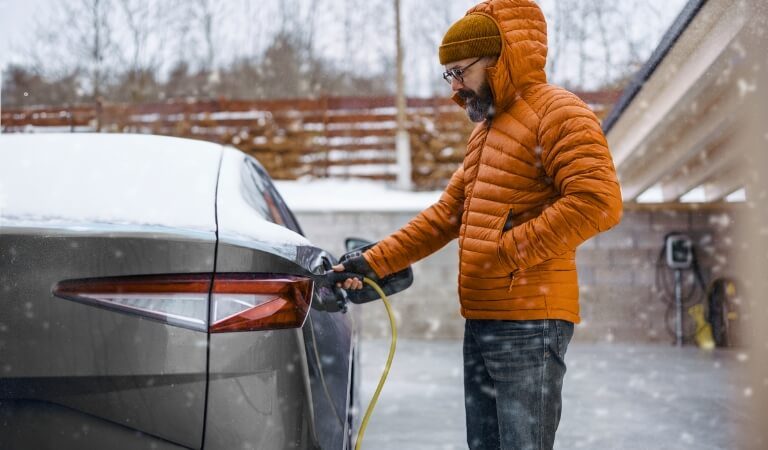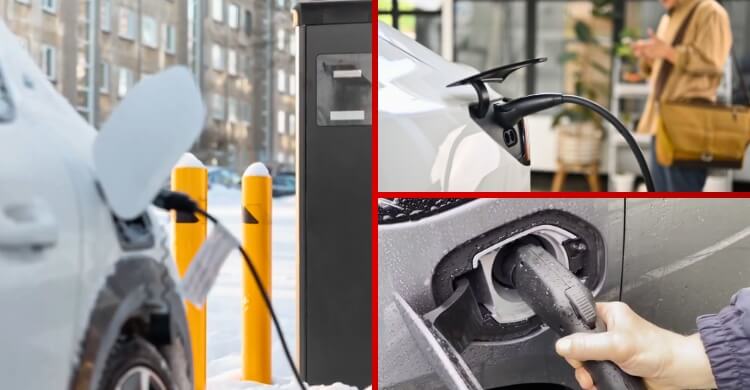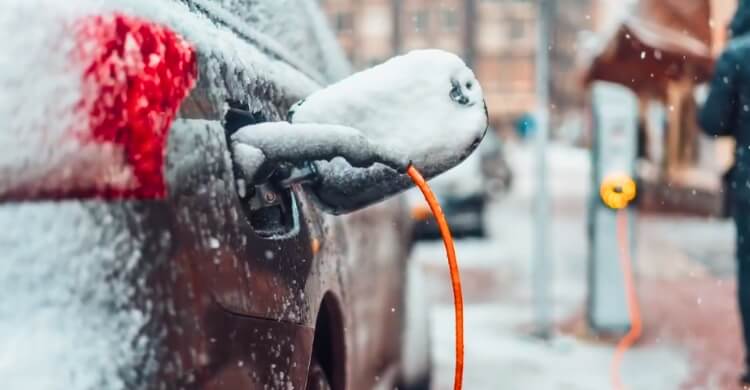The winter can be tough on your electric vehicles. As a result, you may notice that charging at charging stations is more difficult, there is a shorter range, and there is a longer wait time. Cold temperatures affect how EVs perform, especially when it comes to the battery.
This is why many drivers feel a difference during the colder months. So, does cold weather affect EV charging?
Yes, it does. Cold temperatures make lithium-ion batteries less efficient. This slows charging speed, reduces energy use, and cuts down driving range. But there’s good news—preconditioning your battery can help improve performance in winter.
Want to know how to prepare your EV for winter and keep your range strong? Keep reading to learn simple tips and how to stay ahead of cold weather challenges.
Does Cold Weather Affect EV Charging?
Electric vehicles are growing fast in Bangladesh, especially in Dhaka and nearby cities. But winter mornings bring fog, chill, and slower charging. Many new EV owners feel confused during these months, mainly because charging behaves differently.
Yes, cold weather does affect EV charging. In colder conditions, charging takes longer, and the battery doesn’t hold energy as efficiently. These changes make a big difference in daily use for EV users in Bangladesh.

Battery Efficiency Drop
When temperatures fall, battery chemicals react more slowly, making the system less active and less efficient than usual. Driving short routes in the early morning reduces the battery’s ability to charge and hold power. That’s why the range seems shorter even after a full overnight charge.
Many local drivers have reported reduced backup after charging overnight during December and January. Even with regular use, the battery doesn’t deliver expected performance. These drops become more visible if the EV isn’t used daily or stays parked for long.
Slower Charging Speed
Cold batteries don’t charge quickly, which increases overall charging time at both home and public stations. This delay frustrates users who depend on quick top-ups for daily trips. Most owners are unaware of this drop until they experience it firsthand.
Delays are noticeable at charging hubs in cities like Rajshahi, Sylhet, or Chattogram. When queues are long, cold batteries make the waiting worse. Winter nights often result in longer full-charge times than the rest of the year.
Reduced Driving Range
Your EV won’t go as far in winter—even with a full battery, the range can feel nearly 30% shorter. AC or heater use in the cold also takes up extra battery power, reducing how far you can go. Shorter trips become a challenge in regions with colder nights.
In northern parts of Bangladesh like Dinajpur or Rangpur, colder winds and early fog worsen this range issue. Even though EVs are great for city driving, winter conditions reduce their strength. That’s why many people prefer keeping backup charging options nearby.
Heater Usage Impact
Switching on the heater drains power directly from the battery, pulling energy meant for driving. Unlike fuel cars, EVs use the same battery for comfort and mobility. This shared energy use leads to quicker charge loss.
In winter, heaters become essential in hill areas or during late-night travel on highways. Many don’t realize this extra use impacts driving range badly. It’s wise to use seat warmers or low-level heating to save charge.
Preconditioning Benefit
Preconditioning warms up the battery before driving and makes it perform better during cold mornings. This feature is available in many EVs and can be turned on via apps or in-car settings. When used properly, it saves time and power.
Setting a charging schedule helps preconditioning work well before your trip starts. This technique improves charge retention and driving range. Most new EV drivers in Bangladesh overlook this helpful trick in the winter months.
Battery Age Factor
Older batteries show bigger drops in performance during cold months, especially in used imported EVs. Their chemical balance weakens over time, and cold worsens it further. Charging takes longer, and energy gets used up faster.
Many EVs in Bangladesh are reconditioned units with some battery wear already. Cold weather multiplies the problem, especially when charging at home without proper voltage control. Battery replacement or a professional check-up may be needed if the drop is regular.
Power Supply Variation
Unstable electricity in some rural areas delays EV charging more during winter nights. Voltage drops make the battery heat up more slowly, causing longer charging time. When the weather turns foggy, power cuts increase in many districts.
This is a common issue outside city zones, where electric vehicle charging stations in Bangladesh are still growing. Users need to plan smartly and check local grid stability. Night-time charging may not work well if power doesn’t stay consistent.
Local Driving Conditions
Rural or uneven roads increase battery stress in cold months, especially when tires grip poorly. This stress lowers the battery’s ability to maintain a consistent charge. Driving in hilly or muddy areas in winter drains power faster than usual.
Colder road surfaces offer more resistance, forcing the battery to work harder. EVs carrying extra load also show faster charge drop on village roads. Keeping the battery warm and checking tire pressure helps reduce loss
How to Reduce the Cold Weather Effect on EV Charging?
Winter mornings can make charging your EV feel slow and less efficient. But a few small changes can improve battery performance. With the right steps, your EV can run better in any cold season. Here are the steps.

Use Battery Preconditioning
Start warming the battery before driving to help it charge quicker and hold power longer during the trip. Preconditioning makes charging more stable when done before cold mornings. Use your EV app or in-car settings to set it easily. Morning routines become smoother when the battery is ready to go.
Charge Indoors When Possible
Indoor charging reduces battery stress from freezing outdoor air, especially during winter nights or early mornings. Parking in garages or shaded spots helps a lot. Covered areas protect the charger and cables from frost damage. Heat stays around the vehicle longer and enhances charging results.
Drive Right Away
Right after charging, start driving to keep the battery warm and active for longer distances without sudden charge drops. Don’t leave the EV idle in cold after charging ends. The battery cools down fast if unused for long. Warm movement keeps battery chemistry balanced and effective.
Limit Cabin Heating
Using seat warmers instead of the full heater saves energy and keeps your battery range steady for longer drives. Heaters pull direct power from the main battery. That leads to faster charge loss even during short drives. Dress warm and reduce cabin heat settings where possible.
Maintain Tire Pressure
Check tire pressure often because colder air drops it, which increases road friction and drains more battery power. Proper pressure supports better grip and smoother travel. Less tire drag means better energy use and longer driving range. Cold roads stress tires more, so check weekly.
Avoid Full Charges
Charging to 100% in winter isn’t always helpful; batteries handle better with 80–90% range for cold conditions. Overcharging stresses the battery more in extreme weather. It’s safer and healthier for battery life over time. Use scheduled charging to stop early when possible.
Can Preconditioning Help Your EV in Winter?
Yes, preconditioning can help your EV during winter by keeping the battery warm before you begin driving. It improves both charging speed and range by reducing the cold’s negative impact on battery performance. Many EV drivers in colder regions notice better morning performance when using preconditioning features. This method prepares the battery to handle power flow more smoothly, even during freezing weather conditions.
Preconditioning also reduces the strain on your EV when charging in low temperatures and helps maintain steady energy output. This is especially helpful when the amperage of a Level 2 EV charger delivers faster charging under ideal battery temperatures. Cold batteries charge slowly, but warm batteries accept energy more efficiently without wasting power. Overall, using preconditioning saves time, improves battery health, and helps maintain stable vehicle performance during winter months.
Myths vs. Facts: Cold Weather and EV Performance
Electric vehicles are rising in popularity across Bangladesh and many other parts of the world. But cold weather brings confusion for new EV owners. Many people believe things about winter and EVs that simply aren’t true. Let’s break down some common myths and show the real facts behind them.
- Myth: EVs can’t run in winter.
- Fact: EVs work in cold, but their battery needs care and warming before driving for best results.
- Myth: Charging stops in freezing weather.
- Fact: Charging works, but it becomes slower as the cold affects battery chemical balance and charging speed.
- Myth: The Battery gets damaged by cold.
- Fact: Cold doesn’t damage batteries directly; it only lowers temporary performance and charging rate until warmed.
- Myth: Cabin heat doesn’t affect range.
- Fact: Using the heater pulls energy from the battery, which lowers your overall driving range in winter.
- Myth: Full charge gives full range.
- Fact: A 100% charge in cold weather still gives less range due to higher power use and slower battery function.
- Myth: Preconditioning wastes energy.
- Fact: Preconditioning saves energy by warming the battery early and improving charging time and battery usage.
- Myth: All chargers work the same.
- Fact: Charger types differ; cold can slow charging unless the EV uses the correct level and temperature setting.
How to Maximize Your EV’s Range in Cold Temperatures?
Chilly mornings and winter roads can shrink your EV’s range more than expected. With a few smart steps, you can avoid extra energy loss. These easy habits help keep your EV running smoothly even when temperatures fall low.

Warm Battery Before Driving
Preconditioning keeps the battery warm before starting the car, which improves both performance and driving range immediately. Many vehicles allow scheduled warming using built-in apps or car settings. This simple step saves energy during the trip and supports battery health. Cold batteries work more slowly, reducing power and response.
Use Eco Driving Mode
Switching to eco mode lowers acceleration and limits unnecessary power use during short or long trips in the winter months. Slower speed reduces battery pressure and keeps energy use balanced. Eco settings are helpful for city traffic and foggy road drives. It improves overall distance without adding driving stress.
Limit Cabin Heating
Reduce heater use by dressing warmly or using seat warmers, which use less battery energy for passenger comfort. Heaters pull energy from the main battery, which shortens travel distance. Setting a lower cabin temperature helps retain more battery for movement. Simple changes like these improve performance in cold weather.
Check Tire Condition
Cold weather drops tire pressure, increasing friction and lowering range—check air levels often to stay efficient. Low tire pressure makes the motor work harder than needed, draining power quickly. Keep tires properly inflated based on EV manual or display alert. Grip improves when tire pressure stays at safe levels.
Plan Shorter Routes
Avoid long unnecessary trips and group errands together to reduce overall battery usage and charge cycles in cold conditions. Keeping the battery warm through continuous movement helps hold power better. Cold starts between each stop increase energy use and drop range. Route planning becomes a powerful winter strategy.
Charge Smartly at Night
Charging during the night and unplugging before departure keeps the battery warmer and ready for use in the morning. Battery warmth helps maintain range and charging speed. If available, use a level 3 EV charging station to reduce charge time and improve battery efficiency. Timed charging works best overnight.
FAQs About Does Cold Weather Affect EV Charging
Cold weather brings several noticeable changes to EV performance, especially when it comes to charging and range. Many users ask questions beyond the basics, looking for clear, practical answers. Here are 10 helpful FAQs you might not have explored yet:
Can Cold Weather Affect EV Charging Cables?
Yes, extreme cold can make EV charging cables stiff and harder to handle, especially when coiled. Store them indoors or in warm spaces to avoid damage and make plugging in easier during the winter months.
Does Cold Impact Home Charging Speed?
Absolutely. Cold weather slows down charging even at home, especially if the EV is parked outside. Using a garage or warming the battery first helps improve charge speed without needing expensive upgrades or stronger equipment.
Do EV Charging Ports Freeze Shut?
Yes, moisture and frost can cause EV charging port covers to freeze, especially overnight. Keeping the port dry or using protective covers helps prevent issues and ensures easy access in freezing conditions.
Should I Keep My EV Plugged in Overnight?
Yes, keeping the EV plugged in helps maintain battery temperature and improves efficiency. Many EVs use thermal systems that run while plugged in, helping prevent deep cold from draining charge too quickly.
How Does Cold Weather Affect Regenerative Braking?
Cold temperatures reduce the battery’s ability to absorb regenerative braking energy. As a result, braking may feel weaker, especially during the first few minutes of driving in freezing temperatures.
Can Wind Chill Impact EV Charging Performance?
No, wind chill doesn’t directly affect the battery, but it can cool the surface faster. This speeds up internal battery cooling, which lowers charging performance and reduces initial driving range after charging.
Should I Avoid Fast Charging in Cold Weather?
Not necessarily, but cold batteries may not accept fast charge efficiently. Letting the battery warm up or using preconditioning helps fast charging work better without long delays or reduced speed.
Can I Use Solar Charging in Winter?
Yes, but solar output is usually lower in winter due to shorter daylight and cloud cover. Cold weather doesn’t stop solar charging, but charging times will be longer unless sunlight is strong and direct.
Does Cold Affect EV Charging App Accuracy?
Sometimes. In low temperatures, apps may show delayed charge times or incorrect range estimates. Battery temperature and charging conditions take time to stabilize, which causes apps to adjust values after a few minutes.
Will Parking Location Change Charging Efficiency?
Yes, parking in open, windy areas cools your battery faster, affecting charge speed. Parking in sheltered, warmer spots like garages helps your battery stay efficient and keeps charging time closer to normal
Wrap Up
Cold weather can make it harder to use an electric vehicle, especially when the battery doesn’t work as well. You may notice that your car takes longer to charge and doesn’t go as far on a full battery.
So, if you ask, does cold weather affect EV charging, the answer is yes—it really does. But don’t worry! You can fix many of these problems by doing simple things like warming up the battery, parking indoors, and driving soon after charging. With just a few smart steps, your EV can still run well, even on the coldest winter mornings.
